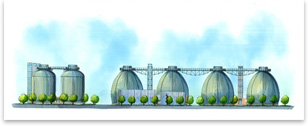
Suman Sorg Designs State-of-the-Art Biosolids Treatment Facility Summary: Sorg and Associates, Washington D.C., has designed a new $311 million biosolids treatment process facility at the Blue Plains Advanced Wastewater Treatment Plant in the Southwest quadrant of the nation’s capital—the largest treatment facility of its kind in the world. Suman Sorg’s design of eight giant egg-shaped digester tanks transforms the landscape into a futuristic plane of animate forms, on eight acres on the shores of the Anacostia River. The facility, a major public initiative of the District of Columbia Water and Sewer Authority, serves more than 2 million customers daily and will process about 350 tons of sludge each day. The architect says the tanks resemble “otherworldly cocoons” and highlight the importance of sustainable urban infrastructure. Sorg notes that the anaerobic system to treat sewage results in more recoverable materials and reduces the output of sludge, resulting in less truck traffic and pollution. She also says the methane captured in the digesters can be used to generate power for the plant. Nestled in two orderly rows of four, the digester tanks measure up to 93 feet at their widest point and rise 108 feet from the ground, with sleek elevator towers reaching up to 120 feet. The digesters take their egg-shape form in part because they are submerged 20 feet into the ground. Delicate forms connect with modern technologies The architect says she is drawn to diverse projects that “keep
the design muscles in tone.” “The delicate, organic exteriors
of the digester tanks provide a necessary balance to the structures’ inherent
industrial character,” Sorg says. “For the first time,
a digester tank facility, commonly disguised by cheap sheathing,
fuses aesthetic concerns with practical realities, thereby creating
a refined, precedent-setting model for the future of treatment plant
facilities.” |
||
Copyright 2006 The American Institute of Architects. All rights reserved. Home Page |
||
news headlines
practice
business
design
recent related
› Sweet Homes, D.C.: 2006 Washingtonian Residential Design Award Winners
› Potomac Valley Chapter Honors 16 Projects
Photo: Image © Sorg and Associates.
A printer-friendly version of this article is available.
Download the PDF file (116 Kb).

 The project includes two silo-like storage tanks
of similar height, two gas equalization tanks, four waste-gas flares,
and a 34,000-square-foot operations building. Sorg adorned each of
the additional buildings with brick and metal cladding to complement
the pre-existing 1930s structures.
The project includes two silo-like storage tanks
of similar height, two gas equalization tanks, four waste-gas flares,
and a 34,000-square-foot operations building. Sorg adorned each of
the additional buildings with brick and metal cladding to complement
the pre-existing 1930s structures.